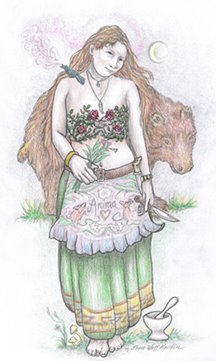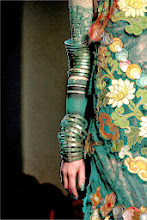
(Salvia spp., Salvia reflexa, Salvia subincisa, Salvia officinalis, Salvia militiorrhiza, Salvia apiana, etc.,)
Energetics
Although the Salvias are sometimes referred to as warming, I have always experienced them as cooling, with certain Sages being downright cold (S. apiana springs to mind) Their astringent qualities point to a drying affect but I think of them as balancing to the bodily fluids, as are many members of the Mint family. I’ve also noticed that the temperature conundrum is also common to many mint family plants, as is their seemingly strange tendency to be called simultaneously stimulating and sedating. In fact, I feel that the energetics of many of the Mint family are innately balancing and this is part of the integral medicine of this plant family.
Historical & Modern Usage of the Many Sages
My main use of our local blue-flowered Sage (S. subincisa also known as Sawtooth Sage) has been for grounding/anti-anxiety purposes... it has worked extremely well for the shaking, nervousness, inability to focus, etc that I’ve experienced since childhood and has allowed me the space and feeling of safety and calm necessary to deal and heal. I have also used the tincture to stop stress-induced tachycardia on numerous occasions. Chinese Sage root (S. militiorrhiza) is a traditional heart and circulation remedy and I wonder if our sages might possess like actions. I have given Sawtooth Sage to clients exhibiting a similar symptom picture to mine with great results every time. It has also been successful as a general grounding agent post-dentistry and post-trauma.
I recently noticed that my experiences closely correspond to the use of blue Salvia flower essence for grounding and also Paul Bergner’s use of Salvia flower essence for extreme stress, I have no experience with flower essences and so was quite surprised and pleased to discover this.
The common Salvia officinalis works similarly but seems to require a larger dose. It is more amenable to tea and food uses, and even as a pleasant and mild smoke or smudge. Maude Grieve quotes Gerard as saying “Sage is singularly good for the head and brain, it quickeneth the senses and memory... restores health to those that have the palsy, and taketh away shakey trembling of the members.” Grieve herself says, “Sage is a valuable agent... in the nervous excitement frequently accompanying brain and nervous diseases... It is highly serviceable as a stimulant tonic in debility of the stomach and nervous system...” T. J. Lyle writes “The leaves are a pleasant, mild, diffusive, stimulating tonic, slightly astringent. In hot infusion it is gently diaphoretic and quite soothing to the nerves” and William Cook recommends Sage for its nervine properties.
I believe there’s something in all of the Salvias that help us let go of the past and be completely present. This is a specific kind of grounding that connects us to our real selves, calming without distancing ourselves from the issues at hand, simply soothing us enough to look life in the face. I think of the Salvias as mother plants, protective and nurturing while teaching us how to take care of ourselves. In a funny way, I feel this corresponds with the old saying that where a sage plant grows well, there lives a strong woman.
Specific Indications
Extreme stress, nervousness, stress headaches, nervous stomach, shaking, dizziness, heart palpitations, inability to mother, nurture or protect one’s self, dissociative disorders with panic, nervous exhaustion...
Science Confirms Experience (Again)
A recent article published by HerbalGram (http://www.herbalgram.org/youngliving/herbalgram/articleview.asp?a=3035&p=Y) explored studies done on S. officinallis’ effect on mood, anxiety and performance. The studies concluded that sage increased alertness, calmness, and contentedness in human trials with a mechanism quite similar to Lemon Balm. This conclusion is in harmony with my own sage experiences and I’m very pleased to see this info available to a larger audience. It’s wonderful when common and widely available plants such as Sage or Elder get some credit in the midst of the Pharma-marketing of endangered or exotic plants and their constituents. Using these plants allows people to grow them in their house or garden, to get to know the plant personally, providing a more intimate and powerful form of healing.
A Cornucopia of Salvias
The well known Garden Sage is but the most common of the many useful sages. Here in the Southwest, there are dozens of Salvia species that are useful in both food and medicine. If you do use Garden Sage, be sure to purchase high grade, organically grown herb or grow your own to ensure the highest quality medicine.
Salvia root, or Dan Shen (S. miltiorrhiza), is traditionally used by the Chinese to sedate or calm the mind. Matthew Wood notes that White Sage is more stimulating than Garden Sage, and I suspect that it might be specifically useful in depression, both internally and as aromatherapy. S. coccinea is quite relaxing, with a stronger sedating effect than Garden Sage or Chán, and has been reported by some to be psychotropic in large doses. Garden Sage is gentle but thorough, not over-stimulating but invigorating nonetheless. The familiar scent and taste is comforting to those who feel shaken, constantly worried and over-extended. Sawtooth Sage (is more intense and specific to the nervous system than many other sages, I recommend 2-4 drop doses of the tincture.
Combinations
Sage makes a great simple, but is so versatile that it has a myriad of complexities that can be developed in herbal combinations. I especially like to use Sage with Rose for women who have been abused or deeply traumatized and are experiencing shaking, confusion and exhaustion with or without nightmares. I also sometimes combine Sage with Motherwort for moody menopausal women experiencing hot flashes, dizziness and tension caused heart palpitations. Used with Skullcap for insomnia caused by tension or fear, I find that the Sage can help to balance the vivid and sometimes disturbing dreams that Skullcap triggers in some individuals. Sage enhances the nerve toning qualities of Skullcap as well. It is also a valuable aspect of many pain formulas as it helps prevent one from the leaving their body because of pain or fear of pain.
Related Uses
I have also found Sage an invaluable ally for headache, failing memory and poor circulation, traits usually credited to its relatives Rosemary and Lavender. These uses have been known traditionally but seem to have fallen out of common use. Grieve states that “A cup of the strong infusion will be found good to relieve nervous headache.” and Culpepper is quoted as saying, “Sage is of excellent use to help the memory, warming and quickening the senses.” Scientific studies have also shown potential for use of S. lavandulifolia as a viable treatment for Alzheimer’s disease.
According to Charlie Kane, Sage’s use as a wound and burn remedy is also comparable to Lavender. My experience with the infused oil, infusion and tincture correspond with this as well. White Sage especially, is an excellent treatment for wounds and burns of all kinds. I recently used White Sage on an old, festering infection that was refusing to heal while becoming more and more painful, two applications of dilute White Sage tincture resolved the infection in twelve hours.
Preparations
Sage lends itself well to any number of herbal preparations including tincturing, vinegar, infused oil, tea, glycerite and honey. I harvest the whole flowering tops of Salvia, but the leaf is what is most commonly available in commerce. I love a combination Rose/Sage glycerite/tincture, the flavor is divine and I carry it with me regularly to ward off tension and the blues. Another excellent preparation is an Sage honey paste made with the whole powdered plant. To make, simply powder freshly dried Sage leaves (Garden Sage is likely the tastiest sage widely available), then heat high quality raw honey until thin and pourable (without boiling), then drizzle over the sage powder and stir until it becomes a thick paste, if the mixture is too thin add more sage powder and if too thick add more heated honey. You can take the honey paste by the spoonful, add it to tea or spread it on toast. You can also form small balls out of the paste, roll them in licorice or maple syrup powder and use them as convenient and tasty herbal pills. Be sure to wrap each pill in plastic wrap or wax paper and store in a cool, dry place.
References:
Herbal Therapeutics: Specific Indications For Herbs and Herbal Formulation by David Winston
American Extra Pharmacopoeia by David Winston
The Practice of Traditional Western Herbalism by Matthew Wood
Medicinal Plants of the Mountain West by Michael Moore
Herbal Medicine of the American Southwest by Charles Kane
Journal of Medical Herbalism by Paul Bergner
The Modern Herbal by Maud Grieve
The New Menopausal Years by Susun Weed
The Encyclopedia of Medicinal Plants by Andrew Chevallier
Saturday, January 13, 2007
Salvia: A Plant Teacher for Grounding & Presence
Posted by
Oakmoss Changeling
at
4:35 PM
![]()
Labels: Medicine Woman Materia Medica
Subscribe to:
Post Comments (Atom)
The Medicine Woman is glad you came...
All writings & posts (c)2007 Kiva Rose
All artwork & photographs (c) 2007 Jesse Wolf Hardin












3 comments:
Hello,
I will be in the Gila area in May and would like to bring back some wild sage for rituals. Would you be willing to offer advice on specific sages and gathering methods to honor the plant and other spirits?
I will also be backpacking in the Gila Wilderness, if you would like to pass on advice on places to visit, I would be honored.
Audri
augdree [at] yahoo.com
Speaking from personal experience sage does work a treat on migraines and headaches.
This is a lovely post on Salvia's! I am writing a post on my garden blog about Salvia's and would like to quote you. Would that be o.k.?
Thanks!
Post a Comment